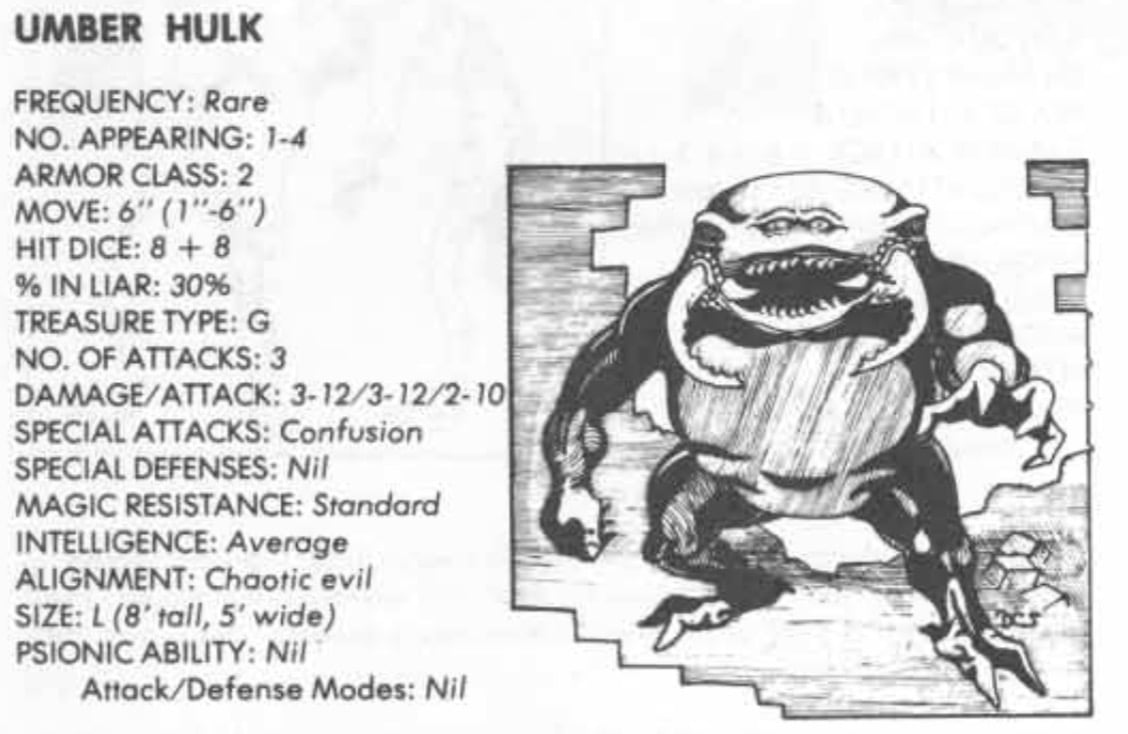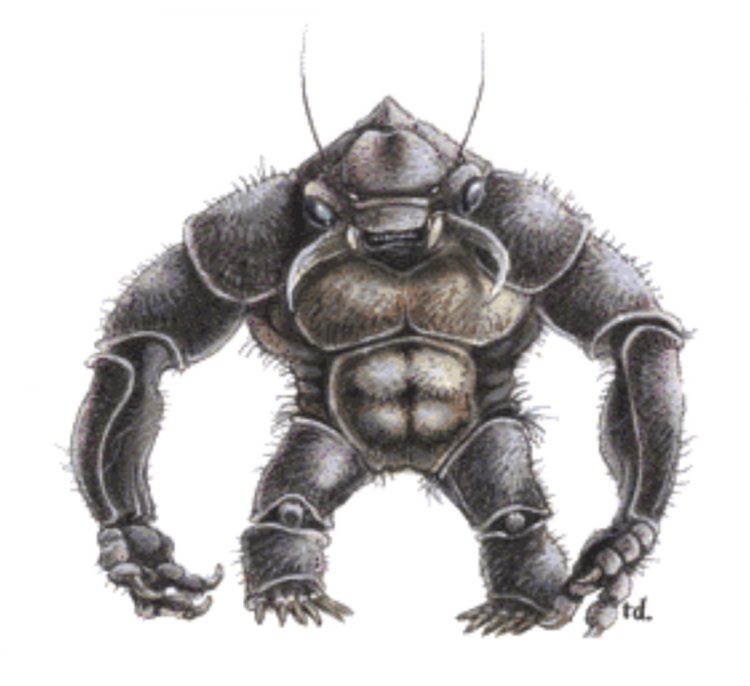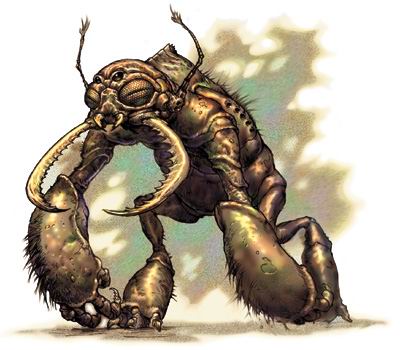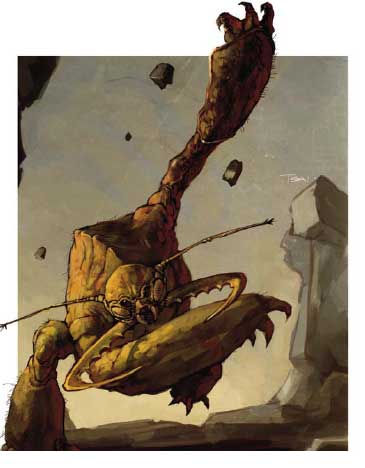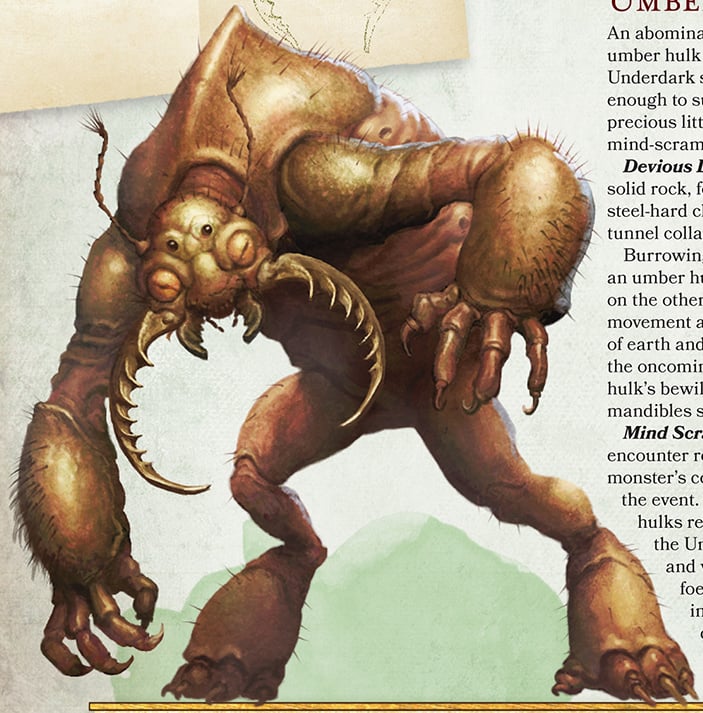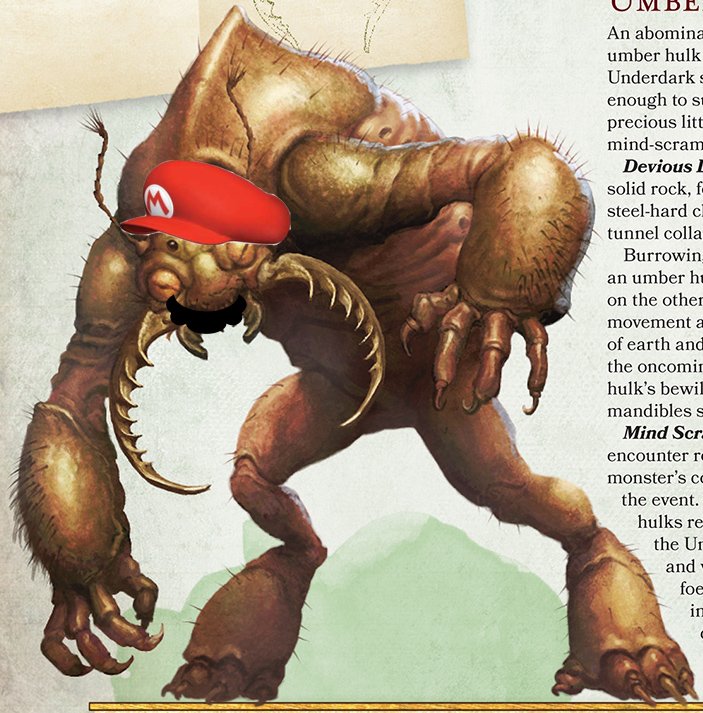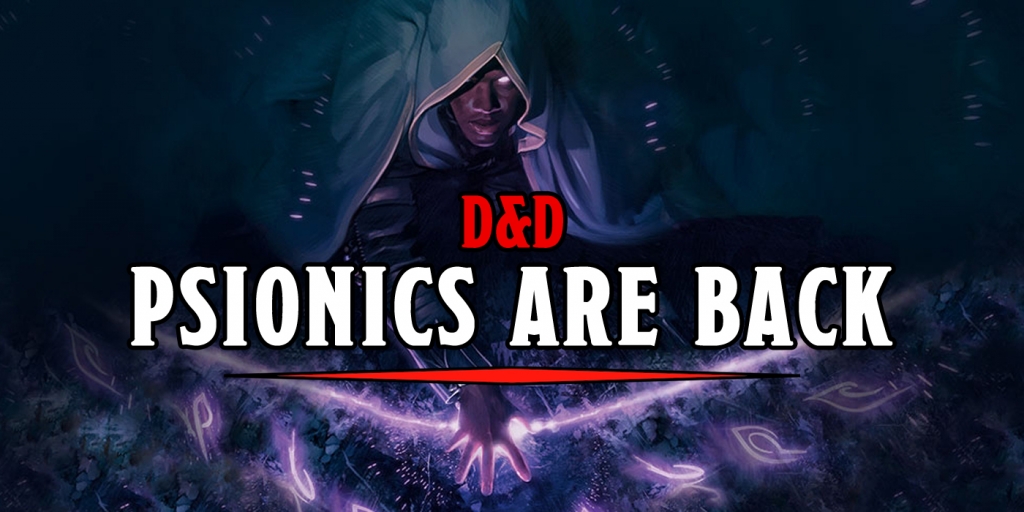D&D: The Umber Hulk Runs Wild On You

Something is bugging me about this week’s monster…it’s left me feeling dazed and confused…
WHATCHA GONNA DO, BROTHER, WHEN THE 24″ PINCERS AND UMBERMANIA RUN WILD ON YOU?!? Bring on your Drow, your Driders, your Derro, Duergar, Deep Gnomes, and Delvers. The Hulkster’s gonna take ’em all on! Better watch out, two pincers, four eyes, and 750 pounds of pure power are comin’ for you this week, as we turn the spotlight to the ring and introduce one contestant you WON’T like when he’s angry: The Umber Hulk!
https://www.youtube.com/watch?v=RKM1AAzeRCg
That’s right. Rising to fame in the early 80s after saving Bob Backlund from a 3-way assault by the Wild Samoans, the Umber Hulk would eventually go on to win the Heavyweight Championship title for 3 consecutive years. Not bad for a kid from the mean streets of a plastic bag labeled “Prehistoric Monsters.” But a lot of legends of the game came from that small town. The Rust Monstertaker, Owlbear the Giant, legends, every last one of them.
Hulk’s legendary style of running wild all over you, brother, is part of what makes him so great. With moves like the Confusing Gaze, the Bull Rush, and the Leg Drop (signature finisher), there’s no shortage of ways that the Hulk can put the hurting on you. You know you’re in for a good fight whenever Hulk shows up. That’s because he’s a part of the game’s history. There’s something about the way he fights, about his character on and off the ring, that make him a part of the very DNA of D&D. So without further adieu, let’s get to the main event.
Ladies and gentlemen… let’s get ready to UMBER…
Like many classic behemoths, the Umber Hulk’s first appearance was in the 1975 Greyhawk supplement where he was described as “of shape somewhat similar to [a] human […] 8′ tall, 5′ wide, with heads resembling bushel baskets, and gaping maws flanked by pairs of vicious mandibles.” Even back then the Umber Hulk had all the hallmarks of his trademark style. Two claws that hit for 2d6 and a bite that does 2d4, along with the ability to tunnel through 1′ of solid rock per turn–here you have all the hallmarks of a fighter destined for greatness
1st Edition firmed up Hulk’s fighting style. Every method of attack available to him got a buff. Claws moved up to 3d4, the bite did 2-10 points of damage (2d5???) and Confusion got increased to last for 3-12 rounds on any adventurer that failed their save. You can definitely see the barrel shape and “bushel basket” head that they talk about. And given their vague ape-like shape, it’s easy to see how they could be mistaken for a different kind of humanoid at ranges of greater than 40.’
We got a better idea of what the Umber Hulk’d been fighting–opponents like the Young Purple Worm and Ankheg. But of course the hulk’s favorite prey is humans.
2nd Edition Hulk is running wild. Bigger, badder, and beefier, 2nd Edition Hulk was much more insect-like. With chitinous armor plating, a much faster burrowing rate (up from 1′ per turn to 10-60′ per turn, depending on whether it was solid stone or soft earthen loam. And this was an era when Hulk was really thinking about the kind of moves available to him–there was a finisher he’d break out during exhibition matches, the Cave-In, which only had a 25% chance of success, but if he pulled it off, it caved in the ceiling, and Hulk could just dig his way to freedom. This kind of success drove him to increase his recognition, appearing in films like Mr. Nanny and Suburban Commando.
Around this time another contender started showing up. An aquatic brother. The Vodyanoi, A lot like the Umber Hulk, but with slimy skin, knobby hide, and webbed claws that shares a taste for man-flesh with its cousin. Though the Vodyanoi had a penchant for bringing electric eels to the match, usually 1-20, and about 50% of the time.
Funnily enough, despite the bigger, badder appearance, 3rd Edition Umber Hulk is almost exactly the same as the previous two generations. Right even down to the 8 hit dice, 60′ darkvision, and lumbering speed. The only real difference is that this one benefits from the generic “burrow speed,” tunneling at 20′ per round through solid stone and earthen loam alike.
But 3rd Edition was also when Hulkamania was running at its most wild, because you got not one but TWO different kinds of Hulkster you could tangle with. Sure there was the standard Hulk everyone knew and love–but then, when things like the championship belt were on the line, he’d HULK OUT and you’d get to see the Truly Horrid Umber Hulk with more than double the hit dice, at least twice the damage, and a confusing gaze that would confound even the hardiest foe, when you saw the Umber Hulk starting to punch and get excited, you knew you were in for a world of pain.
4th Edition Umber Hulk–now there’s an interesting look. Some say he lost touch with his roots, but I think he was experimenting and pushing the bounds of what it meant to hulk out. Burrowing was still there (though dropped back to the classic 10′ per round that everyone knew and loved), but now Hulk had a couple of extra moves like the Grabbing Double Attack, which let him pin an opponent in a powerful submisison hold, dealing 10 ongoing damage with his mandibles each round, leaving a single foe in a heap of trouble. No doubt about it, 4th Edition Umber Hulk was elite.
And because everyone experimented with new looks, 4th Edition also saw another persona. A mysterious Shadow Hulk (although what a missed opportunity to use UMBRA HULK*) appeared which, in addition to the stunning gaze (that made allies turn on each other, what a twist in the match!) had a frenzied attack used when hulking out, in addition to the standard ones everyone knows. Again, bigger and badder, but less popular now that he’d made a heel turn.
5th Edition Umber Hulk is back in fighting form. Making a return to the classic monster that everyone knows and loves, this Hulk has all the usual claw/claw/bites that have made him famous over the years, but also features a slightly more powerful Confusing gaze that an leave foes unsure of what has happened after a match. Like someone who’s suffered a head wound, it might be hard to recall just exactly what the Hulk might have done this time around, as the confusing gaze also has a mind scrambler effect to it.
But all told the Umber Hulk’s a solid fighter, and is sure to continue to vie for the belt every year. That said, the other best thing about the Umber Hulk (aside from what you’ve seen) is that it is ridiculously easy to come up with your own variant umber hulks.
So, with that in mind, as a way of saying thanks for sticking around for so far, let me give you a little bonus.
The Plumber Hulk
It has the ability to make a leaping attack at a target up to 30′ away, dealing 2d8+5 damage on a successful hit, and the target mus make a DC 15 Strength saving throw or be knocked prone.
What kind of variant umber hulks do you have? An encumber hulk? Benedict Cumberhulk? Show us in the comments!


